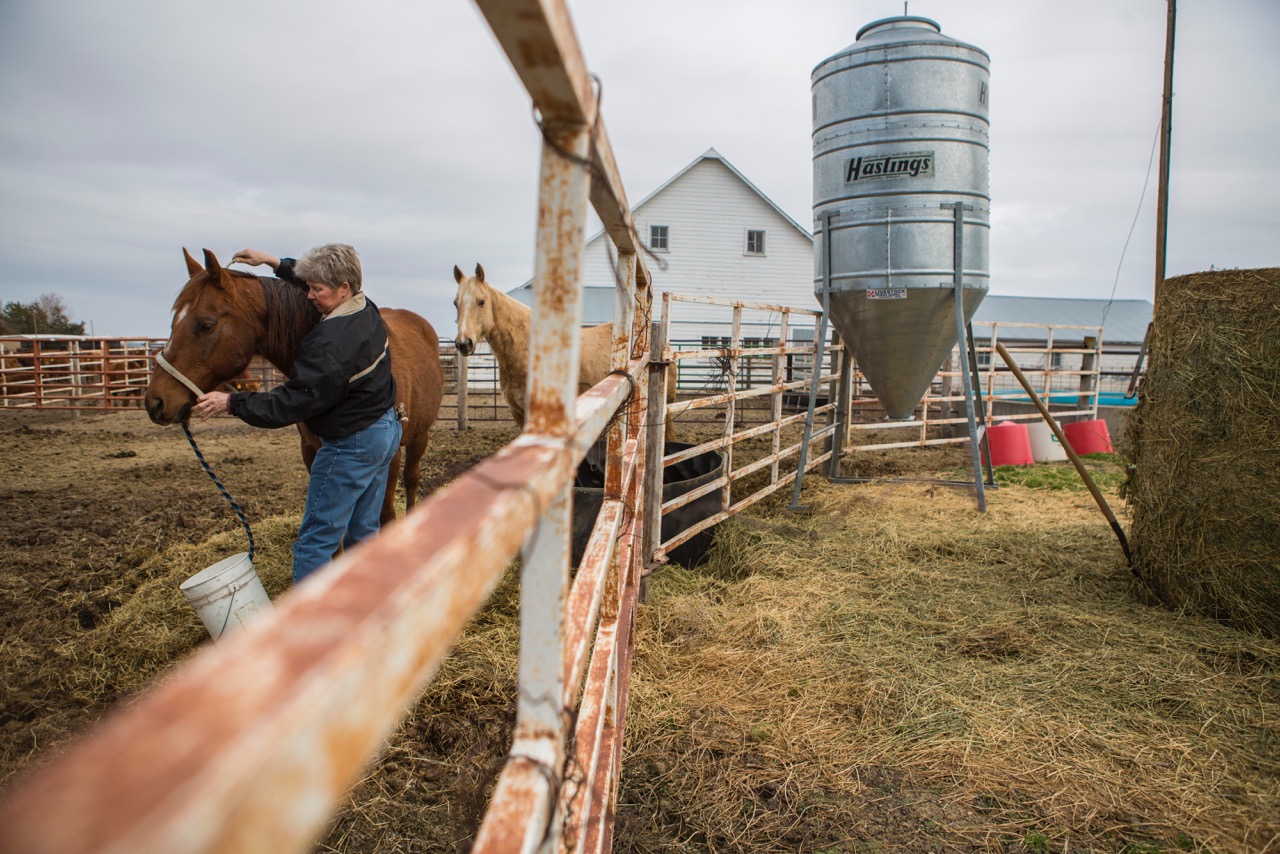

It’s the front feet that come first. Then the head. The rest of the body comes out fast. Sometimes Mary Kay Lyon, 57, has to assist. Sometimes she just has to pull the calf out. Sometimes she needs to wear a glove that stretches all the way up her arm.
On a March afternoon in a muddy pen on Lyon’s 2,500-acre cattle farm near Loomis, Nebraska, a village in Phelps County with a population of about 382, cow number 113, 6 years old, gave birth to a male calf. After more than an hour of labor, Lyon thought she was going to have to pull the baby animal out. She left to prepare, and when she came back just minutes later, the wobbly calf was working to take his first breaths. Lyon poked him in the nose to help clear his nostrils and he lifted his head off the ground and tried to figure out how his body worked. Within five minutes, the red calf, still slimy with amniotic fluid, struggled to stand while his mother cleaned him off with her tongue.
For Lyon, this is a regular day on the job. Her work uniform consists of worn blue jeans, work boots and old leather work gloves. An average of eight to nine calves are born each day on her farm.
According to the United States Department of Agriculture’s 2012 census, 8 percent of the 49,969 farms in Nebraska are run by female principal operators. Lyon said, while it is still uncommon for a woman to run the farm operations, it’s more prevalent now than it used to be. She said she’s never had any gender-related problems while doing business with others, whether it’s a machinery dealer, fertilizer sales person or anyone else she works with in running her operation.
“I’ve always gotten along well with any business people that I’ve dealt with,” Lyon said.
With 180 red angus simmental crossbred cows, Lyon says she seldom needs to get involved during calving season. Her main job is to periodically check the yard to make sure there aren’t any problems. From the time calving season starts in mid-February to the time it ends around the first of May, Lyon checks the cows at least once every three hours, throughout the day. She and her brother-in-law Scott Kreutzer, 53, who lives a quarter of a mile up the road, alternate the night shifts. When it’s Lyon’s night to check the cows, she drives out on her red four-wheeler with a spotlight and looks for any new calves or signs that a cow is nearing labor.
“The ‘kink in the tail,’ we always call it,” Lyon said, describing the tail of a cow about to give birth.
Kreutzer has been helping Lyon with the farm for about 20 years, but Lyon has been farming her whole life.
“Mary Kay is the best farmer there is,” said Joel Bergman, a neighbor and childhood friend of Lyon.
The house she lives in was built by her great grandparents, who moved to Loomis in 1888 from Sweden. They lived in a sod house for six years until they built a permanent home in 1894. Lyon’s parents live in the house as well, and her dad, LaMonte Lyon, can still point to the room where he was born nearly 92 years ago.
“There aren’t that many horses anymore,” he said of the changes in farming he’s seen in his lifetime. “I ‘drove’ a horse to school.”
Lyon grew up helping her dad farm. Despite going to University of Nebraska at Kearney for accounting, she said she always planned to take over the farm.
As she gradually took over the farm responsibilities from her dad, Lyon said she didn’t make too many changes. She grows alfalfa, corn and soybeans, but one she’s chosen not to raise is pigs.
“We did have pigs, but I got really sick of pigs,” Lyon said. “So we will not ever have pigs again. But I like the cows.”
Sometimes, when a cow gives birth, it can get very defensive of its calf, Lyon said. She said she’s learned to tell when a cow has not-so-friendly intentions.
“They will try to kill you,” Lyon said. “You learn to read their eyes and their disposition and their attitude. There’s a time when you just run. Get out. Don’t argue. They’re bigger than you are.”
But there are quiet moments too. Like turning the cows loose in the summertime when the pastures are lush and the calves are playful.
“Life is really good then,” Lyon said. “They look really cute out on the green pasture.”
As Lyon does her afternoon rounds, checking on the cows, she notices all of the new calves. One is all red except for splashes of white around its face that look like a mask. Another is red with white patches scattered along its stomach and legs.
“See that one that looks like he’s got socks?” Lyon says. “Cute little bugger, isn’t he?”